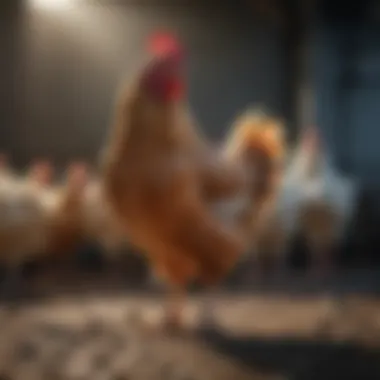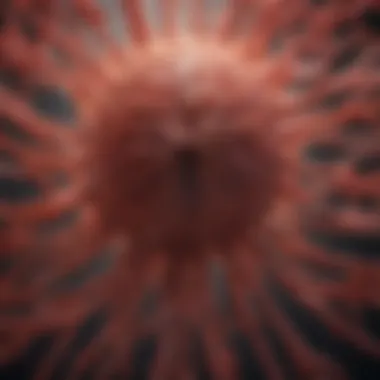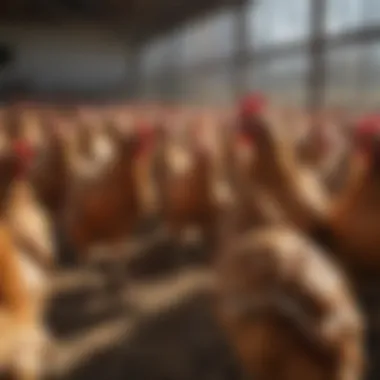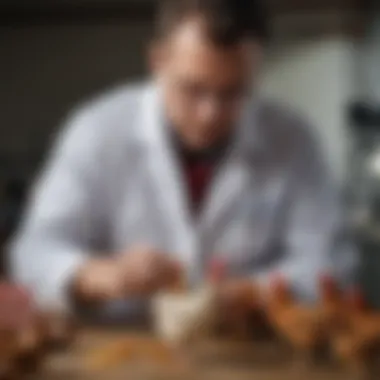Marek's Disease in Chickens: Understanding and Managing


Intro
Marek's disease is a viral infection that poses significant threats to poultry, particularly chickens. The disease, caused by the Marek's disease virus (MDV), is known to induce various health challenges in affected birds. Poultry farmers and agronomists must grasp the intricacies of this disease to effectively manage outbreaks and maintain the health of their flocks.
Understanding Marek's disease encompasses various aspects, including its transmission, symptoms, and ways to prevent its spread. The knowledge of key concepts and terminology related to this disease is crucial for recognizing its implications on poultry production. Awareness not only aids in the diagnosis but also informs effective management strategies.
In this article, we will explore a comprehensive guide to the impact of Marek's disease in chickens, focusing on essential concepts, recent advancements, and practical techniques for management. By synthesizing information through various sections, we aim to equip readers with insights that support proactive measures to safeguard their flocks from Marek's disease.
Preamble to Marek's Disease
Marek's disease is a critical health concern for poultry, particularly chickens. Understanding this viral infection is essential for anyone involved in poultry farming or care. The disease is not only a matter of animal welfare but also affects economic outcomes in the poultry industry. By grasping the intricacies of Marek's disease, stakeholders can implement informed strategies that uphold flock health and productivity.
Overview of Marek's Disease
Marek's disease is caused by the Marek's disease virus, which is a type of herpes virus. It primarily targets chickens and can lead to severe health issues, including tumors in various organs and tissues. Affected birds may exhibit a range of symptoms, from weight loss and lethargy to paralysis and death. The virus spreads easily, primarily through contaminated dust and feather dander, posing significant risks to poultry populations. Awareness of the disease's characteristics is vital for effective management and prevention strategies.
Historical Perspective
Marek's disease was first identified in the early 20th century. It has since evolved into one of the most significant viral infections in chickens. The disease was initially characterized by a lack of understanding concerning its transmission and impact. Over time, research has revealed the mechanisms by which the virus spreads and how it can lead to various clinical presentations. The development of vaccines in the 1970s marked a turning point in combating Marek's disease. However, the emergence of new virus strains continues to challenge poultry health management.
Causative Agent
The causative agent of Marek's disease is crucial in understanding this viral infection, as it forms the basis for various aspects of its management and control in poultry production. Marek's disease is primarily caused by the Marek's disease virus (MDV), a highly contagious virus that primarily impacts chickens. This understanding is vital for poultry farmers and enthusiasts, as recognizing the characteristics of the virus helps in the development of effective strategies for diagnosis and treatment.
Description of the Virus
Marek's disease virus belongs to the family Herpesviridae. It was first identified in the 1960s and has since been shown to cause a variety of clinical signs in affected chickens. The virus is enveloped, containing double-stranded DNA, and has several specific features that influence its behavior and transmission.
MDV primarily targets T-lymphocytes, a type of white blood cell essential for the immune response. Once infected, these cells begin to proliferate uncontrollably, leading to the development of tumors in various organs such as the liver, spleen, and nerves. This pathological change signifies a serious threat to chicken health.
The virus is also known for its unique capacity to establish latency in the host after initial infection. This characteristic means that even after recovery, the virus can persist in the chicken's body, allowing for reinfection under stress or immunosuppression. This trait complicates control measures, as vaccinated birds may still harbor the virus despite not showing symptoms.
Genetic Variants
The Marek's disease virus has several genetic variants that contribute to its complexity and the challenges associated with managing the disease. These variants are categorized into different serotypes, primarily SEROTYPE 1, SEROTYPE 2, and SEROTYPE 3. The differences among these strains play a significant role in the severity of the disease they cause and their response to vaccination.
SEROTYPE 1 is the most virulent and is typically associated with the clinical forms of Marek's disease. It poses the highest risk to poultry flocks, leading to debilitating disease and economic losses.
SEROTYPE 2 is less virulent, and it is often utilized in live vaccines due to its ability to induce a protective immune response without causing severe disease. Understanding this genetic aspect is important for developing effective vaccines that can help in managing Marek's disease cases.
SEROTYPE 3, also known as the non-pathogenic strain, does not cause the disease but can interfere with the immune response associated with other pathogenic strains.
The emergence of virulent strains further complicates the landscape of Marek's disease management. Continuous monitoring of genetic variants is essential to stay ahead of the virus and ensure that vaccination strategies remain effective.
"The genetic variation of the Marek's disease virus underscores the need for adaptable strategies in vaccination and disease management practices."
In summary, understanding the causative agent— the Marek's disease virus and its genetic variants— empowers poultry producers to formulate appropriate diagnostic, treatment, and preventive measures. This knowledge provides a pathway toward minimizing the impact of Marek's disease on chicken health and overall poultry production.
Transmission Dynamics
Understanding the transmission dynamics of Marek's disease is crucial to managing its impact on chicken populations. This disease, primarily affecting young chickens, can lead to significant health complications, affecting not only the birds but also the economic viability of poultry operations. Focusing on transmission allows farmers to implement effective management strategies, minimizing disease incidence and ensuring flock health.
Modes of Transmission
Marek's disease spreads mainly through airborne virus particles shed by infected chickens. The virus can be found in the dander, feces, and respiratory secretions of birds, making it highly contagious. When new birds are introduced to a flock, they are at immediate risk if they are not vaccinated against the virus. The infectious nature of Marek's disease means that even birds that appear healthy can be carriers, further complicating control efforts.
Key modes of transmission include:
- Direct Contact: Infected birds can transmit the virus through close proximity, especially in crowded conditions.
- Environmental Contamination: The virus can survive in the environment for long periods, especially in dust and bedding. This persistence allows the virus to remain in areas even after infected birds are removed.
- Fomites: Objects such as equipment, clothing, and shoes can also serve as vehicles for virus transmission, bringing the pathogen into previously healthy flocks.
It is essential for poultry farmers to recognize these modes to implement biosecurity measures effectively. Practices such as introducing new birds from reputable sources, maintaining cleanliness, and avoiding overcrowding can drastically reduce transmission risk.
Environmental Factors
Environmental conditions play a substantial role in the transmission of Marek's disease. Factors such as temperature, humidity, and management practices can influence the virulence and spread of the virus. Here are some considerations regarding these environmental factors:


- Temperature and Humidity: Warm and humid environments may facilitate virus survival outside the host. Marks on feathers and dander in these conditions can contribute to higher airborne concentrations of the virus.
- Housing Conditions: Poor ventilation and overcrowding increase the likelihood of transmission. Properly designed housing with good air circulation can help mitigate these risks.
- Sanitation Practices: Regular cleaning and disinfecting of housing, equipment, and feed areas can reduce environmental viral loads. Use of appropriate disinfectants is necessary to eliminate the virus effectively.
By acknowledging how Marek's disease spreads, one can arm themselves with the knowledge to implement preventative measures, ultimately safeguarding flock health and productivity.
For more comprehensive details on poultry health management, visit Wikipedia.
Clinical Signs and Symptoms
Understanding the clinical signs and symptoms of Marek's Disease is crucial for poultry farmers and enthusiasts. Early recognition of these indicators can lead to timely intervention and management, potentially saving flocks from severe losses. Marek's Disease, caused by a herpesvirus, can manifest in various ways, meaning symptoms often differ significantly among infected birds.
Pathology Overview
Marek’s Disease primarily affects chickens, leading to a range of pathological changes in various organs. The virus can cause tumor development, particularly in lymphoid tissues. This transformation impacts normal physiological functions, leading to several observable clinical signs. For example, affected birds may exhibit signs of paralysis, presenting with a wing or leg drop, or may show abnormal eye signs that can include iris color changes or even blindness. Importantly, the presence of these signs can vary depending on the strain of the Marek's virus and the age of the chickens.
The likely progression of the disease often features an asymptomatic phase, complicating management. As chickens become more symptomatic, signs like labored breathing or weight loss can occur. Identifying these changes promptly is essential since they indicate a worsening condition, often requiring immediate action. Moreover, flock health management can greatly benefit from recognizing pathological indicators, as it can drive vaccination and treatment decisions.
Differential Symptoms by Strain
Marek's Disease exhibits diverse symptoms depending on the strain of the virus infecting the chickens. The classic strain, which is considered the most aggressive, tends to cause rapid tumor development and severe neurological signs. Birds infected with this strain may show sudden onset of paralysis, often leading to misdiagnosis as other diseases like Newcastle disease.
In contrast, less virulent strains might produce more subtle symptoms, such as slight weight loss or lethargy, making them easier to overlook. This variance makes it vital for poultry caretakers to be vigilant for any changes in behavior or physical condition of their flocks.
Some key indicators to differentiate symptoms by the strain include:
- Aggressive Strain: Marked neurological signs, significant weight loss, early mortality.
- Less Virulent Strain: Subtle weight loss, reduced feed intake, mild lethargy.
- Eye Symptoms: Varied among strains, with serious strains causing more severe ocular changes.
Recognizing these strain-specific symptoms allows for more tailored approaches in management and treatment. Farmers who understand the nuances of symptoms in relation to viral strains will be better equipped to handle Marek's Disease effectively, protecting both their investment and the health of their flocks.
The significance of monitoring clinical signs and symptoms cannot be overstated. By establishing a routine observation process, poultry producers can enhance their biosecurity measures and response strategies, ultimately mitigating the risks associated with Marek's Disease.
"Identifying clinical signs early is key to a successful management plan."
Diagnosis
Diagnosing Marek's disease is crucial for timely intervention and management within flocks. Accurate diagnosis minimizes potential losses for poultry farmers. It enables the identification of affected birds, allowing for prompt isolation to prevent further spread of the disease. Moreover, understanding the signs and responses to the disease helps practitioners refine their management strategies.
Clinical Diagnosis
Clinical diagnosis involves observing clinical signs and symptoms exhibited by affected chickens. Marek's disease commonly presents as lameness, abnormal pupil size, and neurological symptoms. Farmers and veterinarians must be vigilant in recognizing these signs early. A thorough clinical examination should include a detailed history of flock health. This allows for recognizing patterns typical of Marek's disease, helping distinguish it from other diseases presenting similar symptoms. It is important to take into account any recent changes in flock behavior or health.
Laboratory Techniques
For definitive diagnosis, laboratory techniques are vital. Two of the primary methods used include Polymerase Chain Reaction (PCR) and Serological Tests. Both offer unique insights that help determine the presence of Marek's virus.
Polymerase Chain Reaction (PCR)
PCR is a widely recognized method for detecting Marek's disease. This technique amplifies small segments of DNA, allowing for the identification of the virus even at low levels. PCR is particularly valued for its speed and sensitivity, providing results within hours. The specificity of this technique helps ensure accurate identification of the virus, reducing the chances of false positives.
Despite these advantages, PCR does have some limitations. It requires well-equipped laboratories and skilled personnel to perform the test correctly. Additionally, while PCR can detect the virus, it cannot measure the level of contagiousness in a flock, which can be critical for management decisions.
Serological Tests
Serological tests assess the immune response in chickens by detecting antibodies against Marek's virus. These tests are significant as they can identify infected birds even if they show no clinical signs. This ability is crucial for managing flocks by highlighting asymptomatic carriers that could spread the virus.
Serological tests are generally easier to conduct than PCR, often requiring less sophisticated equipment. However, they do have drawbacks. A potential delay between infection and antibody production means the test may not detect the virus during acute phases. Moreover, it is important to understand that a positive result indicates exposure, not necessarily active disease.
Understanding these laboratory techniques is essential for effective Marek's disease management.
Treatment Options
Understanding treatment options for Marek's disease in chickens is crucial for both flock health and economic stability in poultry farming. The application of appropriate treatments can help manage the symptoms, reduce mortality rates, and enhance the overall well-being of the birds. It is also essential to recognize that Marek's disease continues to evolve. Thus, staying informed about the latest treatment strategies is vital for any poultry farmer or enthusiast.
Currently Used Treatments
Treatment for Marek's disease primarily focuses on supportive care and symptom management since a definitive cure does not exist. Current approaches include:
- Vaccination: This is the most effective way to reduce the incidence of Marek's disease in poultry. Vaccines like the HVT (Herpes Virus of Turkeys) have been in use, providing a level of immunity against the disease. However, vaccinated birds can still become infected, but they may exhibit milder clinical signs.
- Supportive Care: Ensuring proper nutrition and hydration is essential for birds showing signs of Marek's disease. Supplementing their diet with vitamins and minerals can improve their immune response.
- Culling: In severe cases where infection spreads rapidly, it may be prudent to cull affected birds to prevent further transmission within the flock.


"Vaccination remains the frontline defense against Marek's disease, reinforcing the importance of preventive measures in poultry management."
Challenges in Treatment
While various treatment options exist, several challenges complicate the management of Marek's disease:
- Vaccine Efficacy: Vaccines do not guarantee complete immunity. New strains of the virus can emerge, which may evade vaccination, leading to breakthrough infections.
- Rapid Spread: The highly contagious nature of Marek's disease can make containment difficult once an outbreak starts. Immediate action is necessary, but treatment options may be limited in the early stages.
- Economic Considerations: Implementing and maintaining effective treatment protocols may be financially burdensome for smaller operations. Costs associated with vaccination, supportive care, and culling can accumulate quickly.
Preventive Measures
Preventive measures play a critical role in managing Marek's disease in chickens. These strategies are essential to reduce the incidence of infection and safeguard the health of the flock. Effective prevention not only protects individual birds but also contributes to the overall productivity and economic viability of poultry farms. Implementing sound preventive practices can significantly mitigate the impact of this disease.
Vaccination Strategies
Vaccination against Marek’s disease is one of the most effective preventive strategies available. Vaccines stimulate the immune system of chickens, preparing them to fight the virus effectively. The commonly used vaccines include the Marek’s disease vaccine, which is administered during the first day of life. This early vaccination is crucial as it provides a foundation of immunity before the chicks are exposed to the virus in their environment.
It is essential for poultry farmers to select the right vaccine based on the specific needs of their flock. There are different vaccines tailored to various strains of the Marek's disease virus. Hence, consulting with a veterinarian for guidance on which vaccine best suits the farm's conditions is a recommended practice. Additionally, monitoring the flock post-vaccination is vital. This monitoring ensures that the vaccination is effective and helps identify any potential issues early on.
Management Practices
Aside from vaccination, management practices are key to preventing Marek's disease. Good biosecurity measures can minimize the risk of introducing the virus into a flock. Biosecurity includes controlling access to poultry housing, maintaining cleanliness, and preventing contact with wild birds, which can carry the virus.
Nutritional management also influences the health of the birds. A balanced diet can bolster the immune system, making chickens more resilient against infections. Farmers should ensure that their chickens receive essential nutrients, including vitamins and minerals that aid in immune function.
Furthermore, environmental management is crucial. Ensuring adequate ventilation in housing can reduce moisture and improve air quality, thus lowering stress levels in the birds. It is also important to provide ample space for chickens to move, as overcrowding can lead to increased stress and vulnerability to diseases.
In addition to these practices, regular health assessments can help in early detection of symptoms, allowing for timely intervention. Overall, a combination of proper vaccination, robust management practices, and ongoing monitoring creates a comprehensive approach to controlling Marek's disease in poultry operations.
Impact on Poultry Industry
Marek's disease poses a significant threat to the poultry industry, influencing both economic outcomes and production practices. Understanding its impact is crucial not only for farmers but also for the sustainability of poultry farming as a whole. With the landscape of poultry production evolving constantly, the effects of Marek's disease must be carefully considered to ensure the viability of operations.
Economic Consequences
Marek's disease can lead to substantial economic losses within the poultry sector. The disease affects chickens primarily through immune system suppression, which can result in higher mortality rates. Affected flocks may require additional veterinary care and management, incurring extra costs. Farming operations often face decreased productivity due to the disease, as healthy birds are less able to compete with infected ones. The financial consequences can be profound, as farmers may experience:
- Increased veterinary expenses: Regular health assessments and treatment protocols elevate the financial burden on operations.
- Loss of marketability: If a flock suffers from Marek's, it may become essential to sell birds at a lower price, reducing profit margins.
- Production inefficiencies: The time and resources spent on managing disease outbreaks pull attention away from improving overall production efficiency.
Furthermore, it is crucial to consider the long-term ramifications of Marek's disease, as some affected farms may struggle to regain consumer confidence.
Influence on Production Practices
The presence of Marek's disease necessitates adaptation of production practices in poultry farming. Farmers must prioritize disease prevention and readiness to mitigate economic losses. Key changes in practices often include:
- Vaccination Protocols: Strong emphasis on vaccination strategies becomes essential. Vaccination can significantly reduce the incidence of Marek's disease, including the use of vaccines such as HVT (Herpesvirus of Turkey) and others.
- Biosecurity Measures: Farmers are urged to implement stricter biosecurity measures, maintaining a secure environment for the flock. This can include improving sanitation protocols, controlling visitor access, and ensuring that materials from outside sources are thoroughly disinfected.
- Regular Monitoring: Incorporating routine health assessments helps to identify potential cases quickly before they spread. Early detection can dramatically reduce both mortality and economic costs associated with outbreaks.
Understanding Marek's disease allows farmers to take proactive steps to ensure their operations remain sustainable in the face of this pressing challenge.
Case Studies
Case studies serve as critical tools for understanding Marek's disease in chickens. They provide real-world examples that can significantly add to the knowledge base of poultry farmers and enthusiasts. Analyzing specific scenarios helps in grasping the complexities associated with the disease. These studies illustrate the varied manifestations and impacts of Marek's disease across different environments and farming practices. In this section, we will explore two main aspects: Case Study Analyses and the Lessons Learned.
Case Study Analyses
In any study of Marek's disease, it is pivotal to assess actual outbreaks. For instance, let us examine a scenario from a commercial poultry farm in the Midwest. The farm reported a sudden increase in flock mortality. Initially, the farmers attributed this to poor management practices. However, upon conducting thorough examinations, they found cases of Marek's disease. The analysis revealed several critical factors:
- Age of the Flock: Most affected birds were between 12 to 16 weeks old.
- Vaccination History: A significant number of these birds had not received a proper vaccination.
- Environmental Conditions: High-density housing contributed to stress and enhanced virus transmission.
This case not only highlights the immediate risk associated with naïve flocks but also signals the need for robust vaccination strategies and housing practices.
Lessons Learned
From the analysed case studies, several lessons stand out that are essential for preventing and managing Marek's disease effectively:
- Importance of Vaccination: A well-structured vaccination program is vital. In the analysed farm, the lack of vaccination was a primary driver of the outbreak.
- Environmental Management: Proper management of flock density and overall housing conditions can mitigate stress, which is a significant exacerbating factor for Marek’s disease.
- Regular Health Monitoring: Systematic health checks can help in early detection of infections and reduce the impact of Marek's disease.
- Education and Training: Farmers need to be better educated on the risks and management of Marek's disease through continuous training.


Incorporating case studies into the understanding of Marek's disease provides practical insights and reinforces the importance of proactive management strategies. Learning from past outbreaks leads to a more prepared and resilient poultry industry.
Future Directions in Research
The exploration of future directions in research related to Marek's disease is pivotal. This aspect enables scientists, farmers, and stakeholders to stay ahead of the evolving landscape of the disease. Improving understanding of Marek's disease ensures the development of targeted strategies for prevention and management.
Emerging Research Trends
Current research trends in Marek's disease focus on genetic studies and vaccine development. Research is increasingly looking into the genomic variations of the Marek's disease virus and how they affect the virulence and resistance in chickens. Understanding the virus's genome can facilitate the identification of specific strains and their impact on different chicken breeds. Researchers are also experimenting with next-generation vaccines. These vaccines could offer better protection and efficacy against variants of the disease. This research is essential because traditional vaccines may not be effective against newly emerging strains of the virus, which changes rapidly.
Furthermore, studies are examining the immune response in chickens upon exposure to Marek's disease. Insights gained can lead to enhanced vaccine formulations and immunization protocols, ultimately improving flock health. The integration of technologies like CRISPR in breeding programs is another trend. These technologies have the potential to create genetically resistant chicken breeds, thus reducing the impact of Marek's disease.
Innovative Management Solutions
Management strategies must adapt as new research provides insights into Marek's disease. Innovative management solutions are critical for safeguarding poultry health and ensuring productivity. One approach is the implementation of biosecurity measures that go beyond basic practices. These measures can include enhanced sanitation protocols and controlled access to flocks to minimize disease transmission.
Additionally, utilizing data analytics and monitoring systems can improve flock management. Real-time data can help in tracking the incidence of Marek's disease and its symptoms. This allows farmers to react more swiftly and efficiently when symptoms appear, reducing the overall impact of the disease.
Collaboration among researchers, farmers, and veterinarians is essential. By sharing findings and practical experiences, they can develop comprehensive strategies that address the needs of the poultry industry.
Research in nutrition is also relevant. Feeding programs tailored to boost the immune system of chickens can provide an additional layer of protection against Marek's disease. Identifying specific nutrients that enhance immune function will be beneficial in developing targeted feeding strategies.
In summary, focusing on future research helps in adapting strategies for Marek's disease management. Stakeholders must embrace scientific advancements to protect their flocks and improve poultry health.
Closure
The conclusion serves as a significant component of this article, encapsulating the essence of Marek's disease and its implications on poultry. By summarizing the major findings and insights presented, the conclusion reinforces the necessity for awareness among poultry farmers and stakeholders. It pulls together the threads from each section, highlighting how the understanding of this disease can influence management practices.
Summary of Key Points
Marek's disease is a viral infection that poses a serious threat to the health of chickens. Key points include:
- Causative Agent: Understanding the virus and its genetic variants is essential for effective management.
- Transmission Dynamics: Awareness of how Marek's disease spreads and the environmental factors that contribute is crucial in preventing outbreaks.
- Clinical Symptoms: Identifying symptoms aids in timely diagnosis and treatment.
- Treatment Options: While there are treatments available, challenges remain in their effectiveness and accessibility.
- Preventive Measures: Vaccination and good management practices can significantly reduce the incidence of Marek's disease.
- Impact on the Poultry Industry: Recognizing both the economic consequences and influences on production practices is critical for long-term sustainability.
- Future Directions in Research: Ongoing studies and innovative management strategies are vital to outpacing the evolving nature of the disease.
Call to Action for Stakeholders
It is imperative for all stakeholders, including poultry farmers, researchers, and agronomists, to take proactive steps in combating Marek's disease. This includes:
- Increasing Awareness: Keeping abreast of the latest research and developments can empower effective decision-making.
- Adopting Best Practices: Implementing management strategies and vaccination programs diligently can drastically lower risk.
- Collaboration: Engaging with industry peers, veterinarians, and researchers can foster a community approach to tackle this disease more effectively.
- Seeking Resources: Utilize platforms like Wikipedia and Britannica for more in-depth information and studies related to Marek's disease.
"Understanding Marek’s disease isn't just about combating a virus; it's about protecting livelihoods and ensuring a sustainable future for the poultry industry."
By making informed choices and taking necessary precautions, stakeholders can contribute significantly to safeguarding the health of their flocks.
Importance of References
Embedding references within the text helps strengthen arguments, ensuring that the audience relies on verified data. In the context of Marek's disease, accurate sources can offer profound insights into historical research, treatment advancements, and evolving vaccination strategies.
Specific Elements of the References Section
- Credibility: Citing reputable academic journals or publications, such as those found in Britannica or relevant studies on Wikipedia, enhances the reliability of the claims discussed in this article.
- Access to Additional Information: Readers seeking more in-depth exploration can follow the references for broader context or more detailed studies. This aspect is especially important for farmers, veterinarians, and scholars interested in the specifics of Marek's disease management.
- Cross-Verification: Including comprehensive references enables readers to cross-check facts, further encouraging a culture of evidence-based understanding.
Considerations for Effective Referencing
When constructing a powerful reference section, it’s important to consider the following:
- Relevance: Select sources that are directly related to Marek's disease and its implications in poultry farming.
- Authority: Choose well-respected databases or publications that are recognized in the agricultural field to confer authority.
- Variety: Offering a range of sources, from scientific studies to grassroots feedback from poultry farmers, provides a holistic view of Marek's disease.
"Using credible references is not just about listing sources; it is about enriching the narrative with insights from the larger body of work regarding Marek's disease."
Common Questionss
Understanding Marek's disease in poultry is no easy task. This section provides valuable insights into the most frequently asked questions regarding this disease. Addressing these queries is essential to clarify common misconceptions, enhance awareness, and equip poultry farmers and enthusiasts with practical knowledge.
Common Questions about Marek's Disease
- What is Marek's disease?
Marek's disease is a viral infection caused by the Marek's disease virus (MDV). It primarily affects chickens, leading to tumors and neurological issues. The disease can cause substantial economic losses in poultry production, making awareness critical. - How does Marek's disease spread?
The virus spreads primarily through the respiratory route. Chickens shed the virus in their feathers and dander, which can contaminate the environment. Young, unvaccinated birds are particularly susceptible. - What are the signs of Marek's disease?
Symptoms include weight loss, paralysis of the legs, and changes in feather color. Infected chickens may display lethargy and difficulty walking. Observing these signs early can be crucial for management. - How can Marek's disease be prevented?
Vaccination is the most effective preventive measure. There are various vaccines available that can significantly reduce the incidence of this disease when administered at a young age. Good management practices also help limit exposure to the virus. - Is Marek's disease treatable?
Currently, there is no cure for Marek's disease. The focus is on prevention through vaccination and careful flock management. Infected birds often need to be culled to prevent spreading the disease, which poses ethical and economic challenges.
Resources for Further Information
Accessing reliable resources empowers poultry farmers and enthusiasts with knowledge. Consider these valuable materials:
- Wikipedia - Marek's Disease
An informative general overview of Marek’s disease, its history, and impacts. - Britannica - Marek's Disease
Detailed article covering the virus, clinical symptoms, and control measures. - Reddit - Poultry Community
A platform for sharing experiences, questions, and advice related to poultry management. - Facebook Groups
Join groups focused on poultry farming to connect with others and learn about the latest in Marek’s disease management and prevention.















